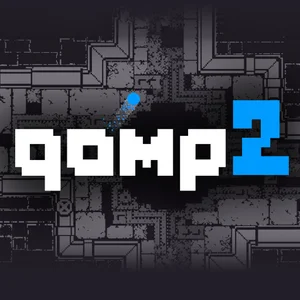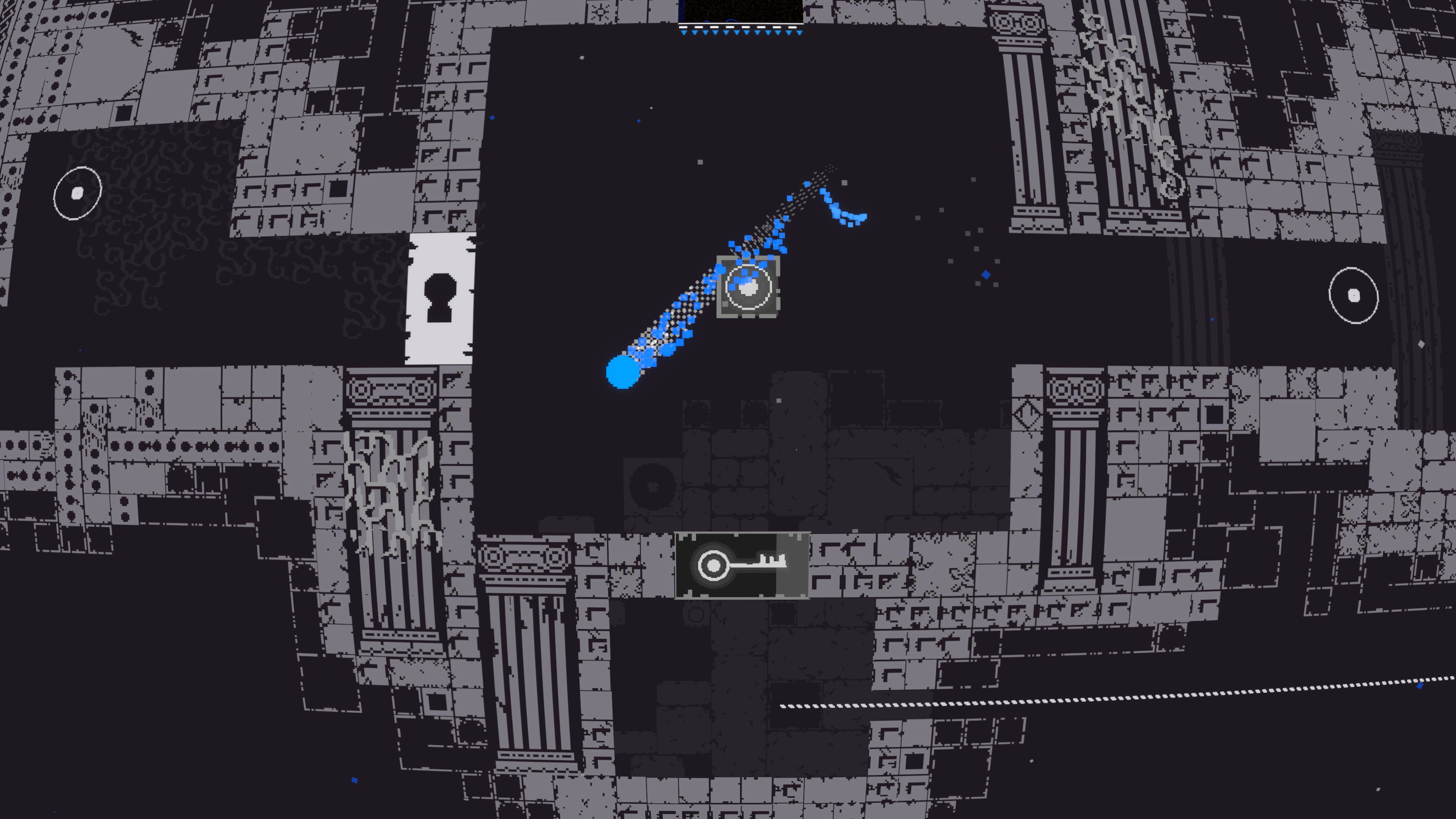Search
[{{{type}}}] {{{reason}}}
{{/data.error.root_cause}}{{{_source.title}}} {{#_source.showPrice}} {{{_source.displayPrice}}} {{/_source.showPrice}}
{{#_source.showLink}} {{/_source.showLink}} {{#_source.showDate}}{{{_source.displayDate}}}
{{/_source.showDate}}{{{_source.description}}}
{{#_source.additionalInfo}}{{#_source.additionalFields}} {{#title}} {{{label}}}: {{{title}}} {{/title}} {{/_source.additionalFields}}
{{/_source.additionalInfo}}- Details
- Category: Computer
- By Jason Gress
- Hits: 1125
qomp2 (PC)

qomp2
Developed By: Graphite Lab
Published By: Atari
Release Date: February 20, 2024
Available On: Atari VCS, PlayStation 4/5, Switch, Windows, Xbox One/Series
ESRB Rating: E for Everyone
Genre: Action, Puzzle
Mode: One Player
MSRP: $19.99
Thank you Atari for sending us this game to review!
Pong. The very first commercially successful video game. Atari got their start with it, and is meant to represent a simple game of table tennis (aka ping pong). Given the limited technology of the time, Pong simulated table tennis by having two vertical rectangles on the left and right sides of the screen, and a single square representing the ball that went back and forth between them. You score by getting that ball past the other rectangle on the opposite side, and they score on you by getting the ball past your paddle. Quite simple, and yet a deserved classic, proving enjoyable gameplay is possible no matter how simple the game is.
The first game called 'qomp' was made by an indie developer group, and Atari loved the idea so much that they acquired the license and published the first game, and now the sequel with different developers, this time Graphite Lab. I did try out that game, but didn't finish it. It's shorter but also less expensive, being the first to try out the idea of what happens to the ball in Pong if it escapes the playing area. Qomp2 has a similar concept, but the idea is much more fleshed out, with quite a few levels and several hidden secrets throughout.
In qomp2, you play with only two buttons. One button moves the ball up or down at a predictable angle, diagonally down or up. The other ball is a boost, which you can use to move faster, or break certain destructible things in the environment. Most things you can break or interact with by boosting are blue in color, but not all, as there are some secrets that don't make it obvious that they are there.
Strong Points: Neat concept; well done atmospheric music and sound effects; lots of extremely challenging secrets and puzzles; works on Steam Deck
Weak Points: Seemingly simple gameplay gets extremely frustrating and difficult; limited resolution options
Moral Warnings: You can die on spikes, fireballs, and so on
The ball always maintains its current left or right direction, so you can't just go anywhere without planning what surfaces you are going to hit that also happen to be spike free. Spikes, sharp enemies, fireballs - there are lots of ways to die. Thankfully, you resume from the most recent checkpoint after you die, and there are many checkpoints available so you don't usually lose all that much progress.
qomp2 uses all pixel art, and by default it visually has a slightly distorted perspective, which is likely meant to simulate playing it on a CRT TV. Everything in the game is flat, as you would expect from a Pong derivative. The music is atmospheric, and sometimes it's pretty neat, especially as it ramps up during boss battles. The sound effects are simple and sound pretty nice. The 'pop' sound when you press the bounce button sounds neat, which is good as you will hear it constantly. By bouncing carefully, you, as the ball, can travel to new screens up, down, left, or right as the need arises.
When the game starts for the first time, you find yourself in the middle of two pong paddles, which are computer controlled. It's clear that the one on the right is not as good at protecting its goal than the other one, and the game is clearly nudging you to go that way. You can also break that paddle with boosts if you wish. This very first section is also a lesson in how to find secrets; if you get past the much trickier left paddle, there is the first secret of the game contained therein. These secrets are collectible teardrops. I would say that many (most?) players will probably want to collect them all, but I assure you that qomp2 does not make that easy. It keeps track of them, so if you are a perfectionist, there is plenty of incentive to retry old levels to collect any that you might have missed. I was able to find most of them, but there were a couple of levels that hid the teardrop so well that I still don't know where it is. There are also hidden exits in qomp2; I found several (most?) of them, but I can't say I got them all. These hidden exits are sometimes extremely difficult to do and I found some of them the hardest thing in the game.

Higher is better
(10/10 is perfect)
Game Score - 80%
Gameplay - 15/20
Graphics - 7/10
Sound - 8/10
Stability - 5/5
Controls - 5/5
Morality Score - 98%
Violence - 9/10
Language - 10/10
Sexual Content - 10/10
Occult/Supernatural - 10/10
Cultural/Moral/Ethical - 10/10
Technically there are lots of puzzles, but by and large everything is about hitting certain targets, activating certain blocks, or avoiding certain death. As the game progresses, your reaction time and forward planning must get better and better if you want those sweet secrets. If I would have just done an endgame speedrun, perhaps I might have gotten through it more quickly, but since I tried to collect every teardrop and find every secret exit, I found myself getting extremely frustrated at times. Those secrets require much more patience and skill than just getting through the levels, though sometimes even that can be tough enough. With that said, thankfully there are assist modes available if you need them. One is much simpler; it just has a line showing you where you will land, making plotting tight pixel-hunting easier. If you really need help, there is an invincibility option that makes the game pretty trivial.
From a PC version point of view, I have only one complaint, and that is that the highest resolution is 1080p. Yes, it's low-resolution pixel art, so you probably wouldn't noticed, but I still prefer pixel-perfect screen ratios when possible. Also, it worked perfectly on Steam Deck and desktop Linux.
Morally, this is about as clean as it gets. You can die on spikes or when hit by fireballs, but that's about it.
qomp2 is an expanded upon take based on the ideas established in the original indie title qomp: what happens to the ball if it escapes the paddles? Who (or what) stands in its way? All of this is done with almost no words. From what I can tell, qomp2 is more an expanded reimagining, so playing the first is not necessary. It's a fun and unique title, and the puzzles can sometimes be wicked hard. While this sequel is certainly more in-depth and longer than the original, by quite a lot, the price is also quite a bit higher. I would say qomp2 is enjoyable and worth experiencing, but I can understand if some choose to wait for a sale. I do recommend playing it if you have a chance; it's quite creative in its idea and execution.








